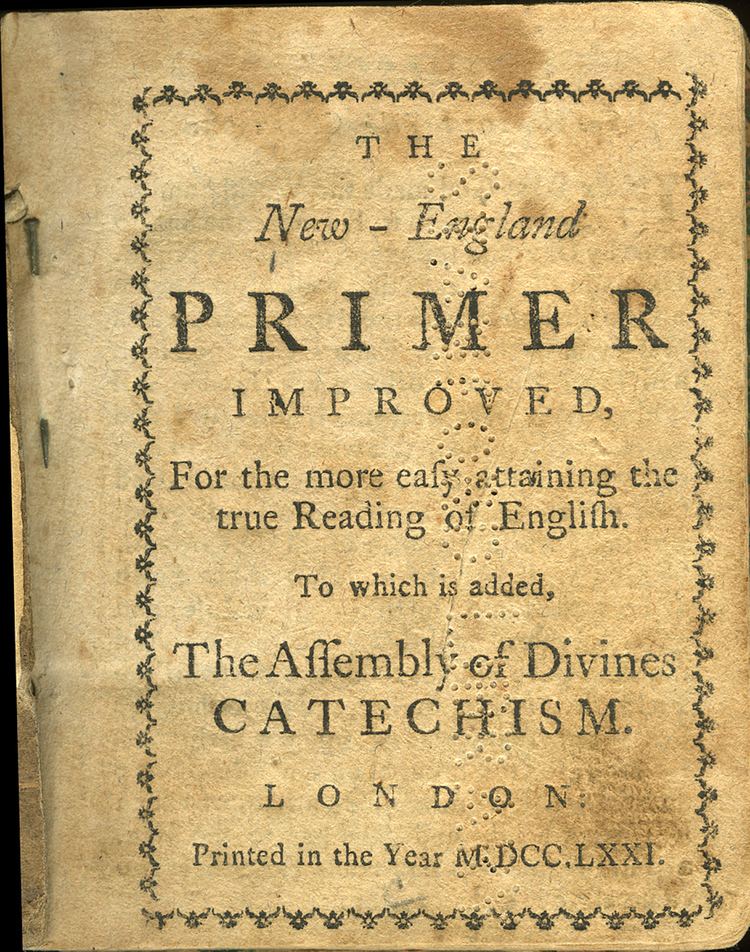Genre Children's literature | ||
 | ||
Similar Christianity books, Children's literature | ||
Book review the new england primer
The New England Primer was the first reading primer designed for the American Colonies. It became the most successful educational textbook published in 18th century America and it became the foundation of most schooling before the 1790s.
Contents
- Book review the new england primer
- History
- Theology
- Contents of the Primer
- Editions and reprints
- References
In the 17th century, the schoolbooks in use had been brought over from England. By 1690, Boston publishers were reprinting the English Protestant Tutor under the title of The New England Primer. The Primer included additional material that made it widely popular with colonial schools until it was supplanted by Noah Webster's Blue Back Speller after 1790.
History
The New England Primer was first published between 1687 and 1690 by printer Benjamin Harris, who had come to Boston in 1686 to escape the brief Catholic ascendancy under James II. It was based largely upon The Protestant Tutor, which he had published in England, and was the first reading primer designed for the American Colonies.
The selections in the New England Primer varied somewhat over time, although there was standard content for beginning reading instruction. Included were the alphabet, vowels, consonants, double letters, and syllabariums of two letters to six letter syllables. The 90-page work contained religious maxims, woodcuts, alphabetical assistants, acronyms, catechism answers, and moral lessons. It was made with a thin sheet of horn or paper shellacked to a wooden board.
The primer remained in print well into the 19th century and was even used until the 20th century. A reported 2 million copies were sold in the 18th century. No copies of editions before 1727 are known to survive; earlier editions are known only from publishers' and booksellers' advertisements.
Theology
Many of its selections were drawn from the King James Bible and others were original. It embodied the dominant Puritan attitude and worldview of the day. Among the topics discussed are respect to parental figures, sin, and salvation. Some versions contained the Westminster Shorter Catechism; others contained John Cotton's shorter catechism, known as Spiritual Milk for Boston Babes; and some contained both.
David H. Watters argues that the Primer was built on rote memorization, the Puritans' distrust of uncontrolled speech, and their preoccupation with childhood depravity. By simplifying Calvinist theology the Primer enabled the Puritan child to define the "self" by relating his life to the authority of God and his parents. Emory Elliott argues that the Primer was part of the transformation that turned Puritans away from an angry and wrathful God the Father to the embrace of the gentle and loving Jesus Christ. Both of these notions, of course, reflect modern worldviews and perspectives, and cannot be assumed to speak accurately on behalf of the seventeenth century Puritans.
Contents of the Primer
Two of the most famous example verses are as follows
Now I lay me down to sleep,I pray thee, Lord, my soul to keep;If I should die before I wake,I pray thee, Lord, my soul to take.—1784 ed.
In Adam's Fall,we sinned all.The text for L is alluded to in Washington Irving's The Legend of Sleepy Hollow: . . . "like the lion bold, which whilom so magnanimously the lamb did hold" ...
Editions and reprints
There have been many reprints of the New England Primer.
